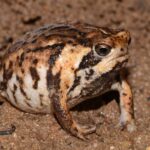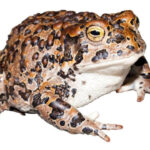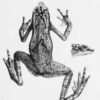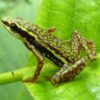Allobates Undulatus: Secrets of the Ripple-backed Amazonian Frog#
A soft patter of droplets cascades from leaves as twilight descends upon the dense, humid heart of the Amazon rainforest. As shadows lengthen, the jungle echoes with the rhythmic chorus of chirps and clicks, signaling that day’s end now gives way to the rainforest’s nocturnal melody. Amid this symphony, hidden beneath carpets of moss and fallen leaves, lives a small, unassuming amphibian whose survival hinges on the delicate balance of this vast ecosystem: the remarkable frog known as Allobates undulatus.
Known to scientists as Allobates undulatus, this diminutive resident of the Amazon basin may not immediately dazzle with vibrant colors or striking size. Yet, beneath its modest appearance, lies an extraordinary tale of adaptation, ecological importance, and conservation urgency. Named for the subtle ripple-like markings traversing its back—evocative of gentle waves flowing downstream—this small frog whispers an ecological story far larger than its delicate body suggests.
Taxonomy and Classification#
Allobates undulatus belongs to the family Aromobatidae, a prominent group of “rocket frogs,” named whimsically for their swift, agile hops and alert postures. Aromobatidae frogs occupy niches throughout tropical Central and South America, encompassing diverse ecosystems from pristine rainforests to grassland edges. Within this taxonomic family, Allobates stands out as a genus distinguished by its terrestrial life habits and elaborate breeding rituals.
The species epithet “undulatus” refers directly to its distinctive, wave-like patterns—the suave curves across its back serving as a unique fingerprint, helping keen observers identify this elusive frog even among closely related species. Closest relatives such as Allobates femoralis and Allobates zaparo share range overlaps but differ subtly enough in calls, appearance, and reproductive strategies, ensuring they remain distinct evolutionary paths within this complex rainforest tableau.
Natural Habitat#
The cradle of Allobates undulatus lies deep within the verdant embrace of the Amazon rainforest, specifically across portions of Brazil, Guyana, Suriname, and French Guiana. Here, beneath spacious canopy layers that intercept sunlight into fragmented beams, the frog inhabits a hidden, microcosmic world among rotting logs, damp leaf litter, and tangled roots—an ecosystem unto itself simmering with biological activity.
A Life in Leaf Litter#
Unlike tree-dwelling species, Allobates undulatus has evolved to thrive in the leaf litter environment—moist, nutrient-rich microhabitats that serve as both hunting grounds and shelters from predators. Each square meter of this fertile ground becomes its vast hunting arena, populated by abundant arthropod prey. The consistent humidity maintained by the dense canopy cover provides optimal conditions for their permeable, amphibian skin, ensuring their delicate moisture balance remains undisturbed.
Microhabitat preference isn’t accidental, but rather a product of millennia-spanning co-evolution. These frogs actively select locations near slow-moving waterways or forest floor depressions, where standing water and dampness harmonize with their reproductive needs. The leaf litter also grants camouflage; its patterning and coloration seamlessly blend with the rippling leaf-back, rendering Allobates undulatus invisible to keen-eyed predators and curious human observers alike.
Physical Characteristics#
Measuring merely 17 to 24 millimeters in length, Allobates undulatus would scarcely fill the space between fingertips. Yet its diminutive size hides an enchanting complexity: a delicate symphony of tans, grays, and browns, speckled with faint highlights of rust or ochre across its flanks.
Distinctive Markings and Camouflage#
The hallmark of the species, however, remains its softly undulating dorsal pattern—a series of gentle waves marking its back, evoking a ripple on still waters at dawn. Subtle yet distinctive, these markings fulfill dual purposes. First, they aid in cryptic camouflage, breaking the frog’s form and merging into the randomness of fallen leaves and tree bark textures. Second, each individual’s unique patterns help field researchers track populations without invasive practices.
Eyes dark as rainforest shadows peer outward with keen sharpness, vigilant for prey and predator alike. Limbs, slender and precisely formed, equip them agilely to leap distances many times their body length. Its compact form conserves energy efficiently, crucial for survival in an environment where resources often fluctuate unpredictably with seasons.
Behavior and Life Cycle#
The twilight comes alive with the melodious, rhythmic calls of male Allobates undulatus, each note deliberate yet delicate, arising as a soft whistle or clicking sequence. These calls—the distinctive songs of courtship—represent the start of a fascinating social interaction underlying this frog’s life cycle.
Courtship and Parental Care#
In response to these serenades, females approach discreetly, assessing candidates through subtle behavioral cues. Courtship unfolds quietly on the forest floor, beneath cover of fallen leaves and moss-covered logs. Female frogs deposit small clutches of eggs in secure, moisture-maintained leaf litter nests meticulously provided by males. Here, their partnership deepens into one of uncommon amphibian responsibility—males diligently guard the developing eggs against fungal infections, predators such as ants and spiders, and even unfavorable fluctuations in climatic conditions.
A Remarkable Journey from Egg to Froglet#
Rather than relying solely on standing water bodies, these remarkable frogs demonstrate a measure of parental dedication rare among amphibians. Upon hatching, tadpoles cling to their father’s backs in a moving tableau of intimate care. The male carefully transports them to small aquatic habitats—ephemeral pools created by recent rains, leaf cup-shaped shelters, or calm, shallow streams—ensuring their safer further development.
Inside these safe havens, tadpoles mature, undergoing slow yet steady metamorphosis. Over weeks, miraculous transformations occur: limbs sprout from bodies adapted for swimming, facial features reshape themselves, lungs take precedence over gills. Eventually, fully-fledged froglets emerge onto land, miniature mirrors of their parents ready to perpetuate this captivating cycle.
Ecological Role#
The gentle Allobates undulatus occupies an essential role within the greater Amazonian community. Acting as both predator and prey, it invisibly stitches together intricate ecological relationships underpinning the tropical forest’s delicate harmony.
Indicator of Ecosystem Health#
This species, relying heavily upon moisture stability and structural forest integrity, serves researchers as a sensitive bioindicator. Amphibians like Allobates undulatus alert conservationists earlier than many other animals to subtle shifts in climate or habitat condition. Their disappearance or dwindling numbers warn clearly of changing rainfall patterns, thinning vegetation, or disease emergence—signposts calling urgently for human-held ecosystem stewardship.
Moreover, this diminutive frog helps regulate populations of insects and other invertebrates, maintaining balance within microscopic forest floor web structures. Simultaneously, it provides nourishment for snakes, spiders, small mammals, and birds. Each interaction, though minute, achieves a collective scale where it shapes entire trophic dynamics.
Threats and Conservation Status#
Like many rainforest inhabitants, Allobates undulatus faces mounting pressures. Habitat fragmentation, rising deforestation rates, and subtle yet pervasive climate changes collectively threaten its survival. Although the International Union for Conservation of Nature (IUCN) currently categorizes this species as “Least Concern,” steady intrusion into their pristine habitats raises alarms among conservationists plotting long-term survival strategies.
Proactive conservation efforts now focus on protecting large expanses of contiguous rainforest habitat, ensuring suitable moisture corridors for amphibians. Sustainable management, habitat restoration, local community education, as well as ongoing amphibian research initiatives form comprehensive tools in preserving vibrant populations of Amazonian Allobates undulatus.
Cultural and Scientific Significance#
Culturally, Amazonian indigenous communities observe subtle yet symbolic connections to rainforest amphibians. Frogs symbolize renewal, fertility, and resilience within traditional stories and ecological teachings that impart respect for nature’s complex interconnectedness.
Scientifically, Allobates undulatus contributes significantly to amphibian research. Its sensitivity to environmental conditions positions it within critical studies regarding amphibian decline and resilience amidst climate change.
Conclusion: A Fragile Symphony Worth Preserving#
Allobates undulatus, diminutive yet faithfully resilient, symbolizes the magnificent complexity hidden within the Amazon rainforest floorscape. Through careful preservation and dedicated research, humans hold the power and responsibility to ensure its quiet call continues echoing into the future, each night a testament to the delicate ecological dance linking our collective wellbeing.
Awareness, proactive oversight, and nature advocacy can protect not only this fragile species but the extraordinary environment it calls home—an ancient forest pulsating with life’s delicate interconnectedness. As stewards of this planet, each commitment today secures tomorrow’s wondrous coexistence.













